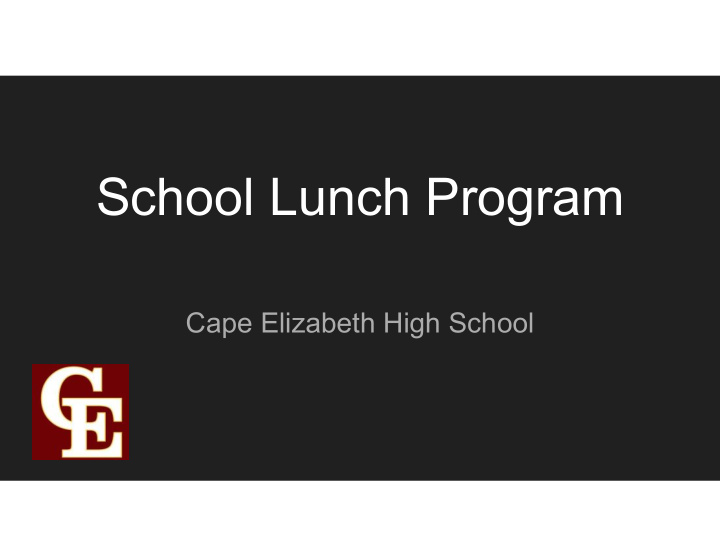



School Lunch Program Cape Elizabeth High School
The School Nutrition Department would like to remove Cape Elizabeth High School from the National School Lunch Program. Restrictions have caused a major impact on how many kids actually eat lunch at school and have limited the choices that we are able to serve our students.These are a few of the reasons why . Certain students being able to leave campus Serving sizes required by the USDA Limiting of alacarte variety Everything whole grain. Less flexibility to create wholesome recipes.
2009- 2012 Our school lunch program was self supporting. We received no monies from the town . From 2009 -2013 Our department was able to generate enough revenue to support all salaries , benefits ,food purchase, equipment repair and also purchase some equipment.
Reimbursement Rates (Lunch) For each complete meal the department receives: Paid Lunch .37 Reduced Lunch $2.97 Free Lunch $3.37
Reimbursement Rates (Breakfast) Paid Breakfast .31 Reduced Breakfast $1.49 Free Breakfast $1.79
Currently we have : 5 Free and 4 reduced students participating at the HS for meals. 5 free lunch reimbursement = 3.37 4 reduced lunch reimbursement = 2.97 ____________________________________________________________ Total loss of reimbursement for Lunch Meals = $28.73
Currently we have 5 free and 4 reduced participating at the HS breakfast program. 5 free breakfast = $8.95 and 4 reduced breakfast $5.96 ________________________________________________________ Total loss of reimbursement for breakfast = $14.91
HHFKA Healthy Hunger Free Kids Act
HHFK Act ● Gives USDA the authority to set new standards for food sold in lunches during the regular day, including vending machines. [11] ● ● Authorizes additional funds for the new standards for federally-subsidized school lunches. ● ● Provides resources for schools and communities to utilize local farms and gardens to provide fresh produce. ● ● Provides resources to increase nutritional quality of food provided by USDA ● ● Sets minimum standards for school wellness policies ● Limits milk served to nonfat flavored milk or 1 percent white milk [12] ● ● ● Reduced portion sizes in meals ● ● Mandate a minimum on fruit, vegetables, and whole grain servings ● ● Mandate a maximum sodium, sugar, and fat content
The Healthy , Hunger Free Kids Act Summary This final rule updates the meal patterns and nutrition standards for the National School Lunch and School Breakfast Programs to align them with the Dietary Guidelines for Americans. This rule requires most schools to increase the availability of fruits, vegetables, whole grains, and fat-free and low-fat fluid milk in school meals; reduce the levels of sodium, saturated fat and trans fat in meals; and meet the nutrition needs of school children within their calorie requirements. These improvements to the school meal programs, largely based on recommendations made by the Institute of Medicine of the National Academies, are expected to enhance the diet and health of school children, and help mitigate the childhood obesity trend.
Results A study done by Harvard School of Public Health discovered that about 60 percent of vegetables and roughly 40 percent of fresh fruit are thrown away due to no interest. [17] Overall, the amount of food students did not eat but threw away instead increased by 56 percent. [18] One of the biggest points of criticism for Healthy, Hunger-Free Kids Act is meal participation, and the participations has not increased, but decreased. [19] The program has declined by nearly 4 percent and some schools have lost revenue due to the decline in participation, therefore, many are choosing to opt out of the program as a whole. [18] In response to the criticism, the USDA issued modified standards which were intended to be more flexible. [20]
New Guidelines We at Cape Elizabeth were very much ahead of the game with our serving fresh fruits and vegetables every day and also with our Farm to school program before it was so big in the news. We had extensive salad bars with many varieties of fresh vegetables and fruit.
Here is our Salad Bar at CEHS
Here is our Deli-Bar at CEHS
What are Smart Snacks in School? What are Smart Snacks in School? Smart Snacks in School refers to the national nutrition standards for foods and beverages sold outside of the federal reimbursable school meal programs during the school day. These items called “competitive foods” because they can compete with participation in school meal programs. As of the 2014–2015 school year, all competitive foods and beverages sold during the school day must meet or exceed Smart Snacks in School nutrition standards, which include limits on fat, sugar, sodium, and calorie content. These standards are the minimum requirement for schools, but states and local education agencies can continue to implement stronger nutrition standards for all competitive foods in schools
Financials 2013-2014 HS Alacarte Revenue $ 107,580.97 Cafe Revenue Transfer .0
Financials 2016-2017 High School Alacarte Revenue $ 18,354.60 Cafe Revenue Transfer $ 87,358.90
Recommend
More recommend